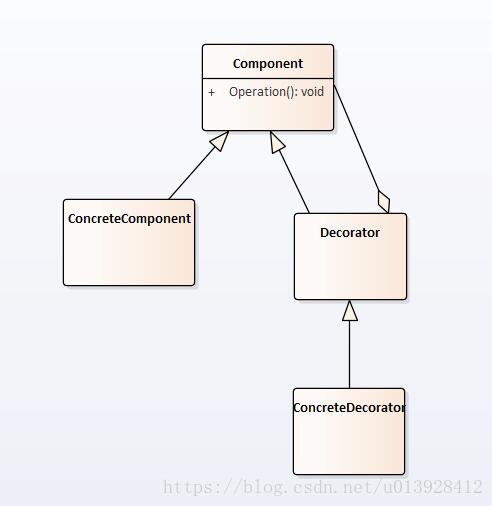java设计模式之装饰模式 java设计模式笔记之装饰模式
孟凡勇 人气:0一、装饰模式的定义
装饰模式是一种比较常见的模式,其定义如下:Attach additional responsibilities to an object dynamically keeping the same interface.Decorators provide a flexible alternative to subclassing for extending functionality.(动态地给一个对象添加额外的职责。就增加功能来说,装饰模式相比生成子类更为灵活)
装饰模式的通用类图如图:

Component抽象构件:Component是一个接口或者是抽象类,就是定义我们最核心的对象,也就是最原始的对象
ConcreteComponent具体构件:ConcreteComponent是最核心、最原始、最基本的接口或抽象类的实现,你要装饰的就是它
Decorator装饰角色:一般一个抽象类,做什么用呢?实现接口或抽象方法,这里面不一定有抽象的方法,在它的属性里必然有一个private变量指向Component抽象构件
具体装饰角色:ConcreteDecoratorA和ConcreteDecoratorB是两个具体的装饰类,你要把你最核心的、最原始的、最基本的东西装饰成其他东西
抽象构件代码:
public abstract class Component {
//抽象的方法
public abstract void operate();
}
具体构件代码:
public class ConcreteComponent extends Component {
@Override
public void operate() {
System.out.println("do somthing");
}
}
抽象装饰者:
public abstract class Decorator extends Component {
private Component component = null;
public Decorator(Component component) {
this.component = component;
}
@Override
public void operate() {
this.component.operate();
}
}
具体装饰类:
public class ConcreteDecorator1 extends Decorator {
public ConcreteDecorator1(Component component) {
super(component);
}
private void method1() {
System.out.println("method1 修饰");
}
@Override
public void operate() {
this.method1();
super.operate();
}
}
public class ConcreteDecorator2 extends Decorator {
public ConcreteDecorator2(Component component) {
super(component);
}
private void method2() {
System.out.println("method2 修饰");
}
@Override
public void operate() {
this.method2();
super.operate();
}
}
场景类:
public class Client {
public static void main(String args[]) {
Component component = new ConcreteComponent();
//第一次修饰
component = new ConcreteDecorator1(component);
//第二次修饰
component = new ConcreteDecorator2(component);
//修饰后运行
component.operate();
}
}
二、装饰的优缺点和使用场景
优点:
装饰类与被装饰类可以独立发展,而不会相互耦合。换句话说,Component类无需知道Decorator类,Decorator类是从外部扩展Component类的功能,而Decorator也不用知道具体的构件
装饰模式是继承关系的一个替代方案。我们看装饰类Decorator,不管装饰多少层,返回的还是Component,实现的还是is-a的关系
装饰模式可以动态地扩展一个实现类的功能
缺点:
对于装饰模式记住一点就够了:多层的装饰是比较复杂的,就像剥洋葱,剥到了最后才发现是最里层的装饰出现了问题,因此尽量减少装饰类的数量,以便降低系统的复杂度。
使用场景:
需要扩展一个累的功能,或者给一个类增加附加功能
需要动态地给一个对象增加功能,这些功能可以再动态的撤销
需要为一批兄弟累进行改装或假装功能,当然首选装饰模式
加载全部内容